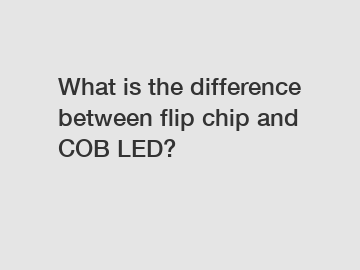What is the difference between flip chip and COB LED?
What is the difference between flip chip and COB LED?
LED technology has revolutionized the lighting industry, offering energy-efficient and cost-effective lighting solutions. Among the various LED technologies available, two popular options are flip chip and COB LED. Both have their advantages and unique features that make them suitable for different applications. So, what exactly is the difference between these two LED types? Let's delve into it.
1. Structure and Design:

- Flip Chip LED: In flip chip LED technology, the electrical connections are made by flipping the LED chip upside down, directly attaching it to the substrate. The LED chip is directly mounted on the printed circuit board (PCB) with its contacts facing down.
.
- COB LED: COB (Chip-on-Board) LED technology involves mounting multiple LED chips directly on the substrate, creating an array of closely packed LED chips. The chips are bonded and connected in series or parallel to form a single lighting unit.
2. Thermal Management:
- Flip Chip LED: Heat dissipation in flip chip LEDs is typically managed through the PCB. Since the LED chip is directly attached to the board, the heat generated during operation is transferred through the board and then dissipated into the surroundings. .
- COB LED: COB LEDs are known for their superior thermal management capabilities. The closely packed LED array enables efficient heat dissipation as the array acts as a larger heat sink, spreading the heat across a larger surface area. This helps in maintaining lower temperatures, reducing the risk of overheating and ensuring optimal working conditions for the LEDs.
3. Light Output and Efficiency:
- Flip Chip LED: Flip chip LEDs are known for their high light extraction efficiency. Due to the absence of wire bonds, the light generated by the chip can be directly extracted, resulting in higher lumen output. Additionally, the chip's contacts are smaller, allowing more space for light extraction, thus enhancing overall efficiency.
- COB LED: COB LEDs are renowned for their high-quality light output. The closely packed LED chips in a COB module can work together to produce a uniform and bright light, minimizing pixelation issues. Their high lumen density provides excellent color rendering capabilities, making them ideal for applications demanding accurate color reproduction, such as photography and retail lighting.
4. Cost and Flexibility:
- Flip Chip LED: Flip chip technology involves a more intricate manufacturing process, making the LEDs relatively expensive compared to COB LEDs. However, they offer excellent solder joint reliability and better durability, making them suitable for applications demanding high reliability and ruggedness.
- COB LED: COB LEDs are known for their cost-effectiveness. The packaging process involves simpler techniques, resulting in lower production costs. Moreover, the modular design of COB LEDs offers flexibility, allowing easy integration into various lighting applications.
In conclusion, both flip chip and COB LED technologies have their distinct advantages that cater to different lighting requirements. The choice between the two depends on the specific application and its demands. Flip chip LEDs exhibit excellent light extraction efficiency and durability, making them suitable for high-reliability applications. On the other hand, COB LEDs with their superior thermal management and high-quality light output are favored in lighting installations that require uniform and efficient illumination. Understanding the differences between these technologies can help make an informed decision when selecting the most appropriate LED solution for a particular lighting project.
If you are looking for more details, kindly visit cob chip on board technology, 300 watt cob led, difference between cob and led.

Comments
0